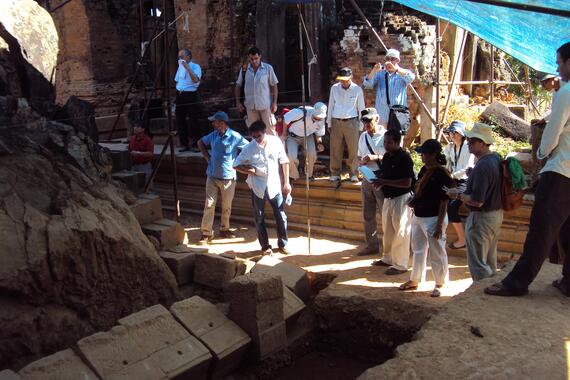World Monuments Fund Mourns the Passing of Professor Giorgio Croci

The staff of World Monuments Fund (WMF) mourns the passing of a great visionary in the cultural heritage field, whose extraordinary contributions will continue to be felt for generations to come. An inimitable talent of structural engineering, Professor Giorgio Croci broke new ground in developing stabilization solutions for some of the world’s most celebrated landmarks. We are fortunate to have benefitted from his exceptional skill and generosity through years of collaboration preserving Angkor Archaeological Park in Cambodia. Our hearts go out to his family, friends, colleagues, and all those affected by this tremendous loss.
Glenn Boornazian, former Program Director for WMF in Cambodia, reflects on the pioneering legacy of Professor Giorgio Croci and his unwavering commitment to saving the world’s cultural heritage.
**********
Last week, the world of cultural heritage preservation lost a crucial leader with the death of Professor Giorgio Croci. Professor Croci was a creative, innovative, and groundbreaking structural engineer who was always on the cutting edge with his imaginative designs for structural stabilization programs for historic buildings, monuments, and sites around the world.
Professor Croci was one of, if not the first structural engineer to devote his professional life to saving cultural heritage sites internationally. As a pioneer in this sense, there was no vast body of knowledge for Professor Croci to draw upon. His work required innovation and he excelled in this regard. The challenges and risks he faced at one-of-a-kind cultural sites were of immense proportions. His challenge was to bring structural stability to destabilized sites by inserting new systems designed to be compatible, yet invisible. He was the author of many books and countless publications which continue to be referenced in academic settings worldwide.
Professor Croci studied at La Sapienza University in Rome where he graduated with a degree in civil engineering in 1960. He became a full professor of structural engineering at La Sapienza in 1984 and then chair of structural analysis of historic buildings and monuments in 1985. From 1995 to 2005, he was President of the International Scientific Committee for Analysis and Restoration of Structures of Architectural Heritage for ICOMOS (International Council of Monuments and Sites), and in 1994, he became a member of the UNESCO standing committee for the preservation of the temples of Angkor in Cambodia. Beginning in 1996, Professor Croci became the scientific coordinator for the restoration of the Colosseum in Rome. From 1998 until the completion of works in 2003, he was a member of the committee which designed the stabilization for the Tower of Pisa, and from 1997 onwards, he was a member of the international study group for the preservation of Hagia Sophia in Istanbul. Also, in 1997, Professor Croci led a team of engineers who were responsible for structurally stabilizing the Basilica of San Francis of Assisi after the devastating earthquake in Assisi, Italy.
In March of 2000, Professor Croci was awarded the silver medal by the Académie d’Architecture in Paris for his contribution to the safeguarding of architectural heritage around the world. Starting in 2005, he was a member of the UNESCO International Committee of Experts for the Safeguarding of the Cultural Heritage of the Old City of Jerusalem, and he was also the designer of the dismantling, transportation, and re-installation of the Axum Obelisk in Ethiopia. In 2008, he was awarded the national gold medal for outstanding merits in the fields of culture and history by Italian President Giorgio Napolitano.
World Monuments Fund (WMF) was extremely fortunate to have had the opportunity to nurture a professional relationship and friendship with Professor Croci while working closely with him at Angkor since his first mission to the site in 1994. He then became one of the UNESCO Ad Hoc Experts of The International Coordinating Committee for the safeguarding and development of the historic site of Angkor and remained committed to this work, returning at least two times a year for over 20 years.
Over the years, WMF continued to benefit from Professor Croci’s interest in our work. He became intimately involved at each of our four projects at Angkor: Phnom Bakheng; the Churning of the Ocean of Milk Gallery at Angkor Wat; Preah Khan; and Ta Som. His positive influence on our team and our work at Angkor is immeasurable.
Professor Croci became most involved with our project at Phnom Bakheng. He made a number of special trips to Cambodia to assist us and attend our Brick Shine Conservation and Stabilization Workshop. He also followed up with additional trips to support the stabilization of one of the brick shrines at Phnom Bakheng which served as a pilot study for future work at the site as well as other temple sites at Angkor.
WMF was honored when, Professor Croci invited me to participate in the development of an important overarching guide to future work within the Angkor Archeological Park entitled Angkor Charter: Guidelines for Safeguarding the World Heritage Site of Angkor.
I speak for all of WMF when I say how thankful we are to have had the opportunity to work with such an exceptional and gifted human being. Our lives and our work have been much improved by the precious time Professor Croci gave to us.
I, along with WMF, send our deepest condolences to his family, friends, and colleagues around the world who mourn this tremendous loss.
Glenn Boornazian
Former Program Director for WMF in Cambodia
